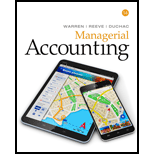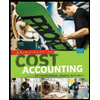
Concept explainers
Sales, production, direct materials purchases, and direct labor cost budgets
The budget director of Gourmet Grill Company requests estimates of sales, production, and other operating data from the various administrative units every month. Selected information concerning sales and production for July is summarized as follows:
Estimated sales for July by sales territory:

Estimated inventories at July 1:

Desired inventories at July 31:

Direct materials used in production:

Anticipated purchase price for direct materials:

Direct labor requirements:

Instructions
Prepare a sales budget for July.
Prepare a production budget for July.
Prepare a direct materials purchases budget for July.
Prepare a direct labor cost budget for July.
1.
Prepare the sales budget for the month ending July 31.
Explanation of Solution
Budgeting:
Budgeting is a process to prepare the financial statement by the manager to estimate the organization’s future actions. It is also helpful to satisfy the everyday activities.
The following table shows the sales budget.
|
Company G Sales Budget For the Month Ending July 31 | |||
| Product and Area | Unit Sales Volume | Unit Selling Price ($) | Total Sales ($) |
| (A) | (B) | (A) × (B) | |
| Backyard Chef: | |||
| M | 310 | 700 | 217,000 |
| V | 240 | 750 | 180,000 |
| N | 360 | 750 | 270,000 |
| Total | 1,070 | 667,000 | |
| Master Chef: | |||
| M | 150 | 1,200 | 180,000 |
| V | 110 | 1,300 | 143,000 |
| N | 180 | 1,400 | 252,000 |
| Total | 440 | 575,000 | |
| Total Revenue from Sales | 1,242,000 | ||
Table (1)
2.
Prepare the production budget for the month ending July 31.
Explanation of Solution
The following table shows the production budget.
|
Company G Production Budget For the Month Ending July 31 | ||
| Details | Units | |
| Backyard Chef | Master Chef | |
| Expected Units to be Sold | 910 | 440 |
| Add: Desired Inventory, July 31 | 40 | 22 |
| Total Units Required | 950 | 462 |
| Less: Estimated Inventory, July 1 | (30) | (32) |
| Total Units to be Produced | 920 | 430 |
Table (2)
3.
Prepare the direct materials purchase budget for the month ending July 31.
Explanation of Solution
The following table shows the direct materials purchase budget.
|
Company G Direct Materials Purchase Budget For the Month Ending July 31 | ||||
| Details | Units | |||
| Grates | Stainless Steel | Burner | Shelves | |
| Required units for production: | ||||
| Backyard Chef | 2,760 (1) | 22,080 (2) | 1,840 (3) | 3,680 (4) |
| Master Chef | 2,580 (5) | 18,060 (6) | 1,720 (7) | 2,150 (8) |
| Add: Desired inventory, July 31 | 340 | 1,800 | 155 | 315 |
| Total units required | 5,680 | 41,940 | 3,715 | 6,145 |
| Less: Estimated inventory, July 1 | (290) | (1,500) | (170) | (340) |
| Total units to be purchased (A) | 5,390 | 40,440 | 3,545 | 5,805 |
| Unit price (B) | $15 | $6 | $110 | $10 |
| Total (A) × (B) | $80,850 | $242,640 | $389,950 | $58,050 |
| Total direct materials to be purchased | 771,490 | |||
Table (3)
Working Note (1):
Calculate the direct material (grates) for backyard chef.
Working Note (2):
Calculate the direct material (stainless steel) for backyard chef.
Working Note (3):
Calculate the direct material (burner) for backyard chef.
Working Note (4):
Calculate the direct material (shelves) for backyard chef.
Working Note (5):
Calculate the direct material (grates) for master chef.
Working Note (6):
Calculate the direct material (stainless steel) for master chef.
Working Note (7):
Calculate the direct material (burner) for master chef.
Working Note (8):
Calculate the direct material (shelves) for master chef.
4.
Prepare the direct labor cost budget of Company G.
Explanation of Solution
The following table shows the direct labor cost budget for stamping, forming, and assembly department.
| Company G | |||
| Direct Labor Cost Budget | |||
| For the Month Ending July 31 | |||
| Particulars | Stamping Department |
Forming Department |
Assembly Department |
| Hours Required for Production: | |||
| Backyard Chef | 460 (9) | 552 (10) | 920 (11) |
| Master Chef | 258 (12) | 344 (13) | 645 (14) |
| Total Hours Required (A) | 718 | 896 | 1,565 |
| Hourly Rate (B) | $17 | $15 | $14 |
| Total Cost (A) × (B) | $12,206 | $13,440 | $21,910 |
| Total Direct Labor Cost | $47,556 | ||
Table (4)
Working Note (9):
Calculate the hours required for the production of backyard chef in stamping department.
Working Note (10):
Calculate the hours required for the production of backyard chef in forming department.
Working Note (11):
Calculate the hours required for the production of backyard chef in assembly department.
Working Note (12):
Calculate the hours required for the production of master chef in stamping department.
Working Note (13):
Calculate the hours required for the production of master chef in forming department.
Working Note (14):
Calculate the hours required for the production of master chef in assembly department.
Want to see more full solutions like this?
Chapter 7 Solutions
Bundle: Managerial Accounting, 14th + Cengagenowv2, 1 Term Printed Access Card
- Which account is a contra-asset?A. Accounts PayableB. Accumulated DepreciationC. Notes ReceivableD. Prepaid Rentneedarrow_forwardIf cash is received before services are provided, what is the journal entry?A. Debit Revenue, Credit CashB. Debit Unearned Revenue, Credit CashC. Debit Cash, Credit Unearned RevenueD. Debit Accounts Receivable, Credit RevenueCorrectarrow_forwardIf cash is received before services are provided, what is the journal entry?A. Debit Revenue, Credit CashB. Debit Unearned Revenue, Credit CashC. Debit Cash, Credit Unearned RevenueD. Debit Accounts Receivable, Credit Revenuecorrectarrow_forward
- GAP Corp. is a calendar year S corporation with three shareholders. George and Anna each own 49 percent of the stock. Peter owns 2 percent of the stock. The corporation was formed on January 2, Year 1, and has been an S corporation since its inception. Using the exhibits, prepare a schedule of GAP's income, gain, loss, and deduction items for Year 2. In column B, enter the amount for federal income tax purposes. In column C, enter the amount included in GAP's Form 1120S ordinary business income (OBI) or loss. In column D, enter the amount included on GAP's Schedule K as a taxable or deductible separately stated item. Each item may have amounts entered in ordinary business income, separately stated items, or both. Enter income and gain amounts as positive numbers. Enter losses and deductions as negative numbers. If the amount is zero, enter a zero (0). A B C D 1 Income, Gain, Loss, and Deduction Items Amount for Federal Income Tax Purposes Ordinary Business Income…arrow_forwardIf cash is received before services are provided, what is the journal entry?A. Debit Revenue, Credit CashB. Debit Unearned Revenue, Credit CashC. Debit Cash, Credit Unearned RevenueD. Debit Accounts Receivable, Credit Revenue need helparrow_forwardDennis Green and Peter Olinto are equal partners in Foxy Partnership. Peter is an active general partner. Dennis is a limited partner and is not involved in the operations of the business. Foxy Partnership's Year 2 financial statements are provided in the exhibits. Using the information provided, enter the appropriate amounts to be reported on page 1 of Foxy Partnership's income tax return in the table below. Enter all amounts as positive whole values. If a response is zero, enter a zero (0). A B 1 Gross receipts or sales 2 Cost of goods sold 3 Salaries and wages 4 Guaranteed payments to partners 5 Repairs and maintenance 6 Bad debts 7 Rent 8 Depreciation 9 Other deductions 10 Ordinary business income (loss)arrow_forward
- Dennis Green and Peter Olinto are equal partners in Foxy PartneDennis Green and Peter Olinto are equal partners in Foxy Partnership. Peter is an active general partner. Dennis is a limited partner and is not involved in the operations of the business. Foxy Partnership's Year 2 financial statements are provided in the exhibits. Using the information provided, enter the appropriate amounts to be reported on page 1 of Foxy Partnership's income tax return in the table below. Enter all amounts as positive whole values. If a response is zero, enter a zero (0). 2. Cost of goods sold 3. Salaries and wages 4. Guaranteed payments to partners 5. Repairs and maintenance 6. Bad debts 7. Rent 8. Depreciation 9. Other deductions 10. Ordinary business income (loss)arrow_forwardIf a business pays off a loan, which of the following will occur?A. Assets and liabilities increaseB. Assets and liabilities decreaseC. Only liabilities increaseD. Equity decreasesarrow_forwardWhich financial statement lists revenues and expenses?A. Balance SheetB. Cash Flow StatementC. Income StatementD. Retained Earnings Statementneedarrow_forward
- No chatgpt! Which financial statement lists revenues and expenses?A. Balance SheetB. Cash Flow StatementC. Income StatementD. Retained Earnings Statementarrow_forwardWhich financial statement lists revenues and expenses?A. Balance SheetB. Cash Flow StatementC. Income StatementD. Retained Earnings StatementNo Aiarrow_forwardWhich financial statement lists revenues and expenses?A. Balance SheetB. Cash Flow StatementC. Income StatementD. Retained Earnings Statementarrow_forward
 Managerial AccountingAccountingISBN:9781337912020Author:Carl Warren, Ph.d. Cma William B. TaylerPublisher:South-Western College Pub
Managerial AccountingAccountingISBN:9781337912020Author:Carl Warren, Ph.d. Cma William B. TaylerPublisher:South-Western College Pub Financial And Managerial AccountingAccountingISBN:9781337902663Author:WARREN, Carl S.Publisher:Cengage Learning,
Financial And Managerial AccountingAccountingISBN:9781337902663Author:WARREN, Carl S.Publisher:Cengage Learning, Managerial Accounting: The Cornerstone of Busines...AccountingISBN:9781337115773Author:Maryanne M. Mowen, Don R. Hansen, Dan L. HeitgerPublisher:Cengage Learning
Managerial Accounting: The Cornerstone of Busines...AccountingISBN:9781337115773Author:Maryanne M. Mowen, Don R. Hansen, Dan L. HeitgerPublisher:Cengage Learning- Principles of Accounting Volume 2AccountingISBN:9781947172609Author:OpenStaxPublisher:OpenStax College
 Principles of Cost AccountingAccountingISBN:9781305087408Author:Edward J. Vanderbeck, Maria R. MitchellPublisher:Cengage Learning
Principles of Cost AccountingAccountingISBN:9781305087408Author:Edward J. Vanderbeck, Maria R. MitchellPublisher:Cengage Learning Excel Applications for Accounting PrinciplesAccountingISBN:9781111581565Author:Gaylord N. SmithPublisher:Cengage Learning
Excel Applications for Accounting PrinciplesAccountingISBN:9781111581565Author:Gaylord N. SmithPublisher:Cengage Learning





